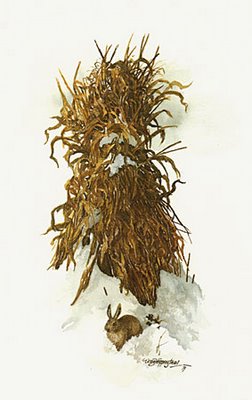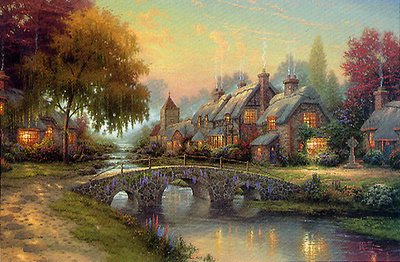 Deep in the Dragon's Claw Mountains are a race of men known as Thanes. These barbaric tribes are a savage lot, nearly as much as the orc they battle for dominance of the mountain expanses. Descended from the same folk that originally settled the region, the Thanes have reverted from their simple origins to a society of tribal warriors and superstitious folk bound by strict laws and codes of honor and taboo.
Deep in the Dragon's Claw Mountains are a race of men known as Thanes. These barbaric tribes are a savage lot, nearly as much as the orc they battle for dominance of the mountain expanses. Descended from the same folk that originally settled the region, the Thanes have reverted from their simple origins to a society of tribal warriors and superstitious folk bound by strict laws and codes of honor and taboo.Central to any Thane village is its Sharl which is the principle shaman and political leader of the group. Sharl's are usually not the most physically able of their people but are without exception the pinnacle of cunningness and guile. Sharl's manifest their authority over their people through the subtle use of politics and the direct manipulation of spiritual and magical power. Most Sharls have a trusted band of servants who, though they may appear as simple functionaries, are usually quite adept in the ways of the warrior, the arts of deception and subterfuge. Such functionaries are known as the Sharl's Shrae.
Second and sometimes nearly equal to the Sharl is the most potent and respected warrior among a Thane village - its Thron. The Thron is a warrior of renown, selected by his people and then subjected to a lengthy process of trials directed by the Sharl. This "approval" process is known as the Kining and it is this process which ultimately decides if a village will get the Thron of its choice. Oddly, few prospective Throns seem to fail their trials. This is due in part to a very complexbit of politics which is know to go on in secret between the Thron, his proponents and the Sharl. It is generally accepted that allowing some other Thron to rise to power within the fringe-bound villages of the Thane would be potentially disastrous.
Thanes make few distinctions between men an women, with both genders fulfilling many of the same roles in their society. Though women are expected to bear children, this is done as a functional practice. Given the tough, physically demanding life of the Thanes, their womenfolk have little difficulty in preparing for the riggers of childbirth and then recovering into a strong, ready warrior mother. Children among the Thanes are considered the children of all adults in the village and take their education and upbringing from any and every adult without exception. So open is this fostering that there are no conventions of heredity in the Thane society with each adult swearing the inheritance of their worldly possessions on their death, a declaration held sacred. Every Thane village has a strong warrior core with the adults and children protected by them as prized treasures.
Though savage and considered vulgar by most civilized people, Thane daily life is designed to enforce the necessity of strength and cunning in the day to day life. Thane warriors are known to decorate themselves with their wealth, wearing precious metals in the form of jewelry and body decoration. Exploits and moments of note in a Thane's life are often recorded through the practices of tattooing and ritual scarring, marks worn with pride and no shame (some Thane are known to tattoo themselves in quite provocative places).
A Thane village is arranged in a radial arrangement with the Sharl's large central Domu hut at the center. The Domu is part council chamber, part temple. It is here that the Sharl meets with the village elders and practices the rites of his craft. Around the Domu are several stone longhouses, each housing from 10-20 Thanes. Each longhouse is an open common room with a private chamber divided off at one end for the headman of the longhouse. The headman is that longhouse's representative to the tribal council.
A Thane village also includes several structures for specific trades and crafts - tanning huts, smoke houses, smithies, drying sheds and storage huts for various dried goods (mostly berries and roots). Around the village, providing a barrier to marauders is a thick stone-faced, log palisade with several watch towers and a signal tower along its parameter. In times of need, the flare atop the signal tower is ignited to alert the Thane of that village and other nearby settlements of that need.
In all the western peaks of the Dragons Claw's there are known to be some two dozen or so Thane tribes totaling to 4000 or more barbarians. If not for the fractured nature of these tribes, the Thanes would surely be threat to any living near them. They are however unable to unite unless presented with a common threat. There is constant conflict on local levels between the Thane tribes and the local Unman tribes.






